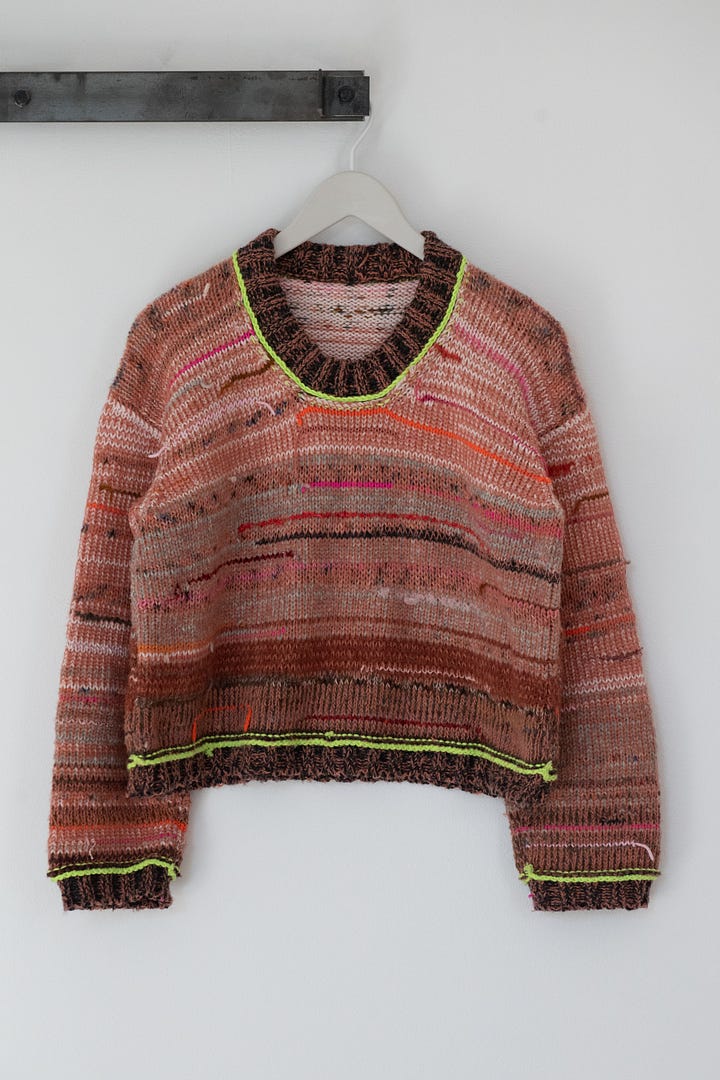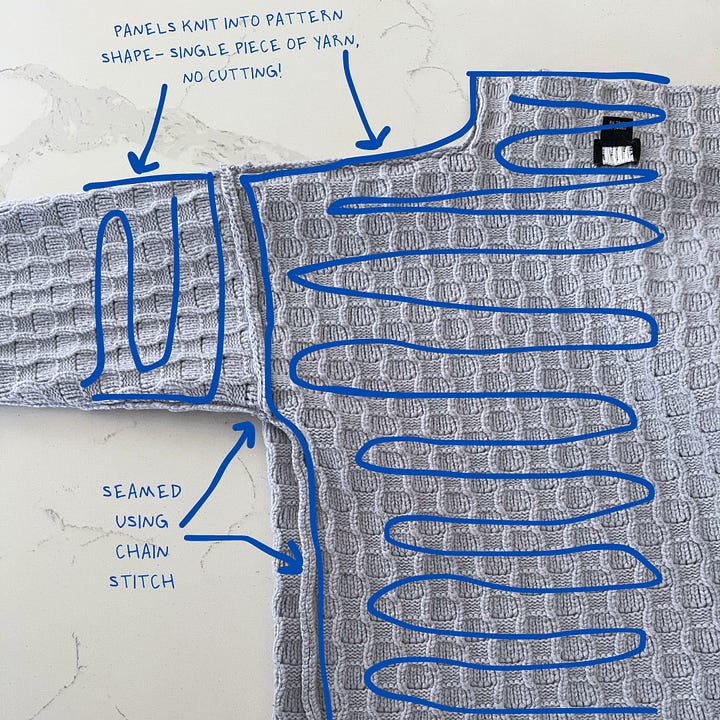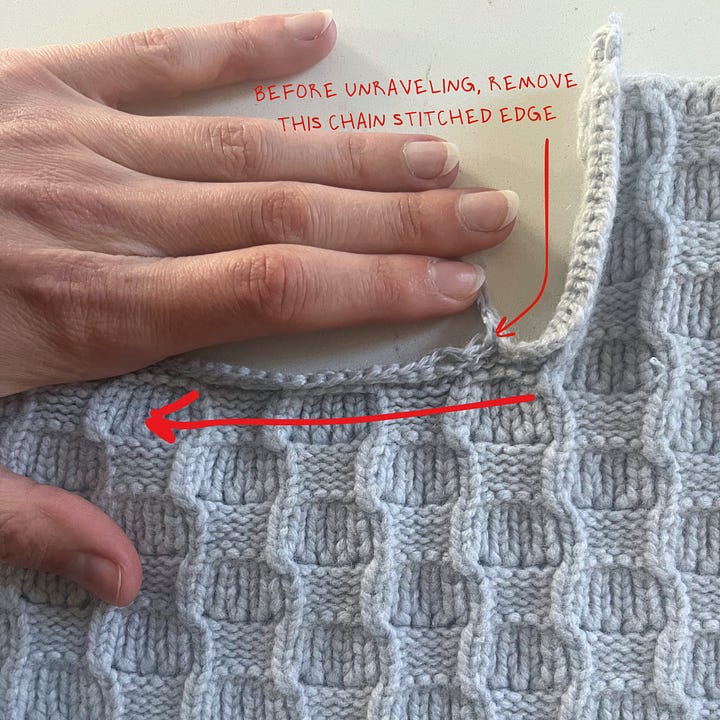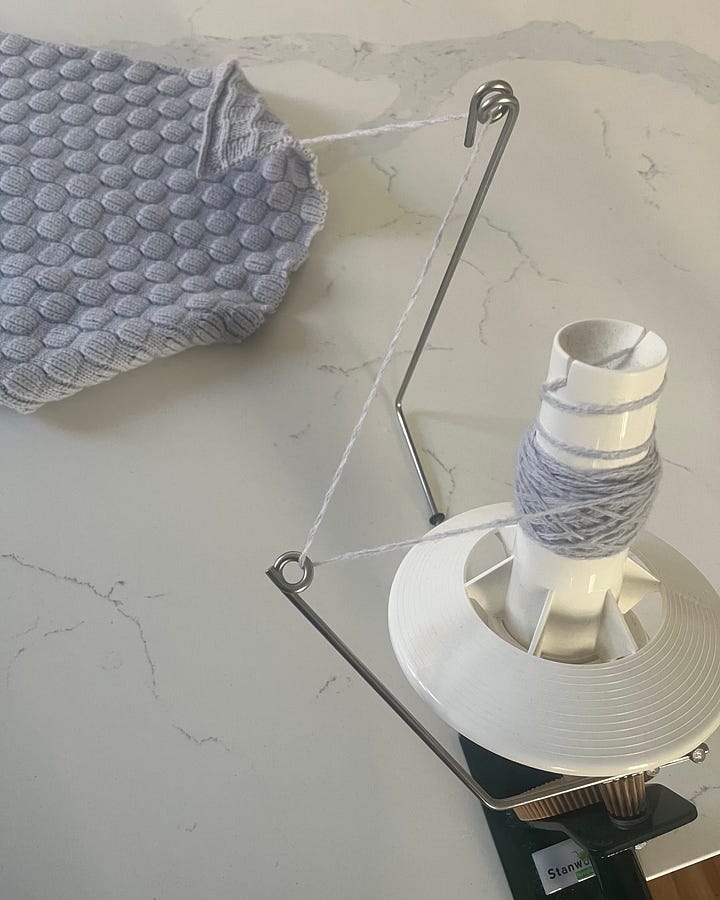Turn your old sweater into "new" yarn
Part 3: A guide to unraveling and re-knitting, the ultimate sweater remix!
Table of contents
Why unravel a sweater?
Learn how to unravel a sweater yourself
Re-knitting: DIY & professional resources
ICYMI - you can read parts 1 & 2 of this three-part sweater ‘repair remix & rewear’ series here:
Why unravel a sweater?
Old sweaters can be a great source of yarn for your knitting / crocheting / fiber arts projects. Some reasons to unravel:
The sweater is damaged / stained and you don’t like it enough to bother repairing it and it’s not in good enough condition to resell or donate.
The sweater is out of style and is not a good candidate for reselling.
Unraveling old sweaters can be less expensive than buying new yarn (especially animal fibers like wool).
You enjoy taking things apart and seeing how you can creatively repurpose them - unraveling is pretty easy and fun!
Examples & Inspiration
Here are some damaged & stained sweaters I’ve unraveled and repurposed:




Learn how to unravel a sweater yourself
What types of sweaters are best for unraveling?
Most store-bought sweaters can be unravelled, and the yarn repurposed for knitting - or for any fiber-based art & craft.
The most important factor to consider when choosing to unravel a sweater is whether your sweater is ‘fully fashioned’ or ‘cut and sew’ -
Fully fashioned
Cut and Sew
Fully fashioned means that the knit fabric of your garment was manufactured into the exact shapes of the pattern pieces, and then joined together (usually with a chain stitch). Most sweaters and knits are fully fashioned (except for knit jersey fabrics, see below).


Cut and sew means that pattern pieces were cut out of a larger swath of fabric, and then sewn together with a sewing machine (sometimes with an overlock edge, or another type of seam). Most knit jersey fabrics (e.g. sweatshirts, t-shirts) are cut and sew, along with most all garments made out of woven fabrics (button-up shirts, jeans, suits, etc.).


Why is this distinction important? You can repurpose nearly all types of garments, by seam-ripping them and treating them like panels of fabric. But only fully fashioned knitwear can be effectively unraveled after disassembling and broken down to its original yarn.
Secondary factors to consider when choosing a sweater to unravel -
Yarn weight
Yarn material & stitch pattern
Garment condition
Yarn weight - I recommend working with chunkier knit sweaters. It’s technically possible to unravel super fine gauge knits, but the yarn would be really hard to manage & work with.
Yarn material & stitch pattern - sweaters of all fiber types (animal, cellulosic, synthetic, blends) can be unraveled, but I generally try to avoid sweaters that look like they might shed a lot or generally be a mess to work with. A good indicator is clearly visible knit stitches - the more distinct the stitches, the easier the garment to unravel. Some of this instinct comes from practice / trial & error!


Garment condition - Unraveling is a great option for hole-y & stained sweaters, but not so good for sweaters that have felted & shrunk. The fibers in sweaters that have started to felt, are effectively matted and stuck together, which will make it very hard to pull back apart. One note about sweaters with holes - holes are places where the yarn has been cut, and therefore you will end up with some shorter bits of yarn around those areas, vs one nice long continuous strand. Still worth it IMO, you can always use the shorter yarn bits for other things.
How to disassemble a sweater
Before you can unravel a sweater, you have to disassemble the sweater - meaning, you need to take it apart at the seams and break it down into individual panels.
And a quick note that probably goes without saying but I’m going to say it anyways - please WASH your sweater before disassembling and unraveling. I always wash before disassembling, and then again at the end once my new sweater is all knit up and otherwise finished. Look out for a future guide to washing / cleaning knits - the quick advice is:
You can hand wash or machine wash most sweaters with gentle detergent & cool water (if you’re using a machine I recommend a delicate cycle & mesh bag).
With animal fiber knits (e.g. wool, cashmere), be careful not to agitate the sweater too much, because friction + heat can cause felting and shrinkage.
Always best to let sweaters air dry flat.
Most pullover sweaters are made of four knit panels - front, back, left sleeve, and right sleeve. As mentioned above, fully fashioned sweaters are generally seamed / assembled using a chain stitch, which makes them relatively easy to disassemble - it’s simply a matter of finding the end of the chain and pulling. Here are some visual guides to disassembling your sweater:


Order of operations:
Start with the wrist, undoing the chain stitch seam up the arm to the underarm, and then down the side seam. Repeat on other side.
Next detach the sleeves from the body. If there is a collar, detach the collar from the body, and finally undo the upper shoulder seams. You should end up with 4 panels + a collar.
TL;DR anywhere you see a chain stitch, you should pull it / undo it :) until your sweater is broken down into all of its discrete pieces.
How to unravel knit fabric
Once your garment has been fully deconstructed into separate knit panels, you can begin the unraveling process. Again, finding the right starting point is key. Here are some visual guides to disassembling your sweater:


The quick points:
Mass produced sweaters are usually knit bottom-up, so you need to unravel from top down.
As mentioned above, sometimes these panels have additional chain stitches - e.g. along the top edge of the sleeves, or the top shoulder seam, in order to stabilize the edge of the panel. You need to remove these stitches before you can unravel the rest of the panel. Sometime these edges are overlocked vs chain-stitched, and the only way to remove them is to cut them off and start unraveling below the cut edge.
Unraveling can easily become a tangled mess, here are a couple of ways to keep your yarn in check:
Unraveling directly onto a yarn ball winder
Or if you don’t have one, use a book or piece of cardboard to create a hank


That’s it! Keep going until you’ve wound up all of the unraveled yarn. Now you have enough yarn to make a new sweater, or whatever else you can dream up.
Re-knitting: DIY & professional resources
DIY Re-knitting
If you’re already a knitter (or crocheter or any other sort of fiber artist) - go forth and unravel old sweaters to make “new” yarn! There isn’t really anything special you need to do / keep in mind when using unravelled yarn vs ~new new~ yarn. If your unravelled yarn is really wavy / kinky, you could try winding it into hanks and steaming it or even hand washing it, but it’s easy to end up with a tangled mess so proceed with caution. I personally choose to wash thoroughly before unravelling, and then I wash (& block) again once my final piece is complete.
Professional Re-knitting
I’m currently aware of two brands that sell sweaters made of unravelled and reknit yarn, Eddys Brand and my own upcycled knitwear company Next Season - but I would LOVE to learn about more knitwear upcycling / re-knitting companies if you know of them!
Eddys Brand - knitwear for children using unraveled & reknit cotton yarn
Next Season - knitwear made with unraveled & reknit yarn (along with post-consumer waste yarn and deadstock / post-industrial waste yarn). Check the made-to-order section of our website if you’re interested in a custom re-knitting project:
Along the lines of reimagining textile ‘waste’ - two other knitwear brands to check out are Waste Yarn Project and The Endery. They don’t work with post-consumer waste (unravelled and reknit yarns), but they do work with ‘deadstock’ yarn aka post-industrial / pre-consumer waste aka the cones of yarn left over from larger industrial production runs.
If you made it this far - I’m impressed, this was a long one! Don’t hesitate to reach out with questions or feedback r.e. unraveling or re-knitting your sweaters :)
I’d love to hear about any sweater repair, remixing or re-knitting projects you’ve started! Drop a comment or connect on Instagram @nextseason.nyc.







WOW, so informative. I feel like that shouldn't have been free to consume!
wow your business model is one of the coolest and refreshing remade way to upcycle i’ve seen in a while!!! kudos and congrats!!